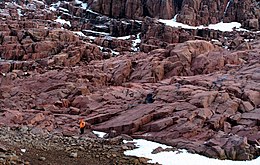 2005 photo of Pim Island | |
| Geography | |
|---|---|
| Location | Northern Canada |
| Coordinates | 78°44′N074°25′W / 78.733°N 74.417°W |
| Archipelago | Queen Elizabeth Islands Arctic Archipelago |
| Administration | |
Canada | |
| Territory | Nunavut |
| Region | Qikiqtaaluk |
| Demographics | |
| Population | Uninhabited |

Pim Island (previously Bedford Pim Island) [1] is an uninhabited island located off the eastern coast of Ellesmere Island, part of the Qikiqtaaluk Region of the Canadian territory of Nunavut. Located within the Arctic Archipelago, it is a part of the Queen Elizabeth Islands.
Contents
Pim Island is separated from Ellesmere Island by Rice Strait, the waterway that connects Rosse Bay to the south and Buchanan Bay to the north. [2] Nares Strait is to the east. Pim Island is 6 kilometres (3.7 mi) from Cocked Hat Island.

